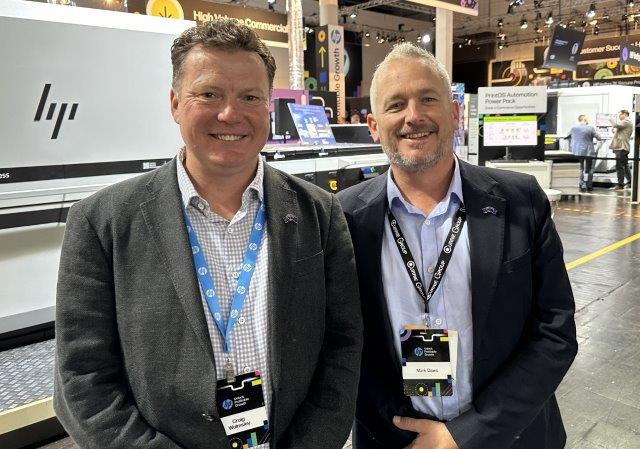Mark Daws, Director – Labels & Packaging ANZ for Currie Group, the ANZ representative for HP Indigo, believes packaging, without question, was the major trend at drupa. “There’s a huge growth explosion in that area, particularly flexible packaging – it represents the biggest growth in digital printing globally.
“And it’s not just traditional packaging or label printers who are exploring its potential. We are certainly seeing cross-cycling, by which I mean people who are in wide-format or commercial printing having really serious conversations about expanding into this area. So, in terms of trends, it’s flexible packaging that really does feel like it’s taking off.”
One of the other major trends evidenced across the HP platform at drupa was diversification. As ANZ Country Manager for HP Industrial Print, Craig Walmsley, elaborated: “For clients that have gone through COVID and have come out the other end, the question is how do we increase that versatility to meet new market trends quickly with high image quality, and how do we match software and finishing for an end-to-end solution?”
Across the HP stand were five major product categories: flexible packaging, folding cartons, commercial printing, labels and publishing. “We’ve enhanced every one of those segments during the show,” noted Craig Walmsley. “Productivity on the factory floor, more automation, the increasing influence of artificial intelligence – bringing all those elements together with solutions like automatic loading and unloading, pallet stackers, using pre-programmed robotic technologies, better software utilisation. It’s all about maximising uptime and productivity, making your workflow more efficient, and being able to increase productivity and grow your business without necessarily having to increase the number of staff through Intelligent Automation. Doing more with less, while enhancing the quality of what you’re doing.”
In terms of HP Indigo products, there was the B2 HP Indigo sheetfed 120K, which offers high quality and high productivity and the HP Indigo 18K with the HD writing head. For labels and packaging, HP committed to each of the three key segments: folding cartons, flexible packaging and pressure-sensitive labels. “For labels, the 6K is still very much the flagship product, and the most commonly purchased press for this market segment,” said Daws. “At drupa, visitors could see it running with digital embellishments, die-cutting, automated setup, register print, less interaction and fast turnaround.”
Then there was the HP Indigo HP Indigo V12, announced last year, incorporating LEPx technology, which accurately attracts each ElectroInk particle to the electrostatic field on the photo imaging drum and manoeuvres the ink to enhance the way it is laid down, allowing a higher definition of 1600 dpi to be achieved. “That’s really driving it as a potential flexo replacement,” commented Daws. “It’s running with a non-stop unwinder and non-stop rewinder, for genuine high-volume productivity. So, a real, digital-only mindset. Coupled with a new ABG Digicon semi-rotary, servo-driven flexo unit and an enhanced semi-rotary die-cutting solution, the machine can die cut, strip and rewind at up to 180 metres a minute. That’s a big increase in throughput, obviously designed to complement the HP Indigo V12.”
The last piece of the puzzle – a slitter rewinder with zero set-up – was on the stand of ABG, for which Currie Group is also the ANZ representative. To maximise throughput, the camera scans the barcode, automatically sets up the knife for slitting and presents the job at the end, ready to be put on the core.
For folding cartons there was the HP Indigo 35K with high definition – another one is being installed shortly into MCC in Melbourne.
“Probably the fastest growing growth in digital is flexible packaging,” confirms Craig Walmsley. “The HP Indigo 200K is the new wide-web version, the next iteration from the HP Indigo 25K. Inline-splitting allows us to run 760 mm, split it in-line, at 56 m/min. Run it at top speed, split it down the middle, and you’re basically running at 120 metres a minute or close to it. A lot of our wide-web users were, in fact, label converters who wanted to branch into bigger runs and flexible packaging with wider formats. So perhaps 50 or 60% of them are actually running labels as well as flexible packaging.”
At the show, the press was complemented by a Karlville combination laminator, incorporating thermal and solvent lamination, again supplied by Currie Group in ANZ. “The next piece of the puzzle would be wide-web splitting. On show was a conceptual design printing digital embellishments in the middle using JetFx, which allows you to put digital embellishments and foil effects onto flexible packaging, something which is already gaining momentum in pressure-sensitive labels. We have just installed the first of these concept machines in Australia,” Mark Daws added.
“We can mount the digital JetFx Print Bar at various widths across any sort of device, whether that’s for label converting, on a printing press, or on a converting line. So, if someone has an old die-cutting varnishing machine, we could give it a new life by putting digital finishing units onto it. There’s going to be a big explosion in that area,” he predicted.
Caption:
Craig Walmsley and Mark Daws of Currie Group on the HP stand which featured five major product categories: flexible packaging, folding cartons, commercial printing, labels and publishing
Click here to discover more on the HP Indigo press portfolio


